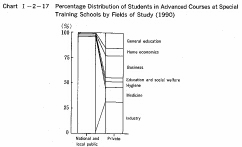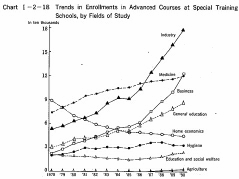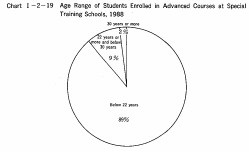| Home > Policy > White Paper, Notice, Announcement > White Paper > JAPAMESE GOVERNMENT POLICIES IN EDUCATION,SCIENCE AND CULTURE 1990 > PART |
||
The system of special training school was institutionalized in 1976. Since then these schools have been steadily developing. In particular, those schools requiring for admission graduation from upper secondary schools are core institutions which enroll about 610,000 students, accounting for 77% of the total enrollment in all special training schools (as of May 1990). Of all new graduates from upper secondary schools advancing to universities, junior colleges or advanced courses at special training schools, one-third enter advanced courses at special training schools. Thus these advanced courses play an important role in the whole post-secondary education system.
In terms of both the number of institutions and enrollments,
the majority of special training schools offering advanced courses are private
ones. In May 1990,the number of private institutions was 2,408, accounting for
88.2% in all institutions in this category. The enrollment of these private schools
was approximately 570,000, accounting for 93.2% of total enrollment in all special
training schools offering advanced courses. These private institutions offer
a wide variety of courses. On the other hand, most of the national and local
public special training schools for advanced courses are nurse training schools
(attached to hospitals or to universities) or other schools in the field of health
service. (See Chart ![]() -2-17.)
-2-17.)

The number of students enrolled in advanced courses increased
by 80% during the ten years between 1980 and 1990. The rate of increase in enrollments
was dramatic for information processing and other industrial courses. Since 1987
the largest proportion of students in advanced courses have been enrolled in
these industrial courses. (In May 1990 approximately 180,000 students were enrolled
in these courses. representing 2.8 times the number in 1980.) While enrollments
in business and health service courses have been increasing. the number of students
in home economics courses has been substantially decreasing. (See Chart ![]() -2-18)(In
the early years immediately after the inauguration of the system of special training
school the largest percentage of students were enrolled in home economics courses.)
-2-18)(In
the early years immediately after the inauguration of the system of special training
school the largest percentage of students were enrolled in home economics courses.)

A majority (52.3%, approximately 320,000) of the total number
of students in advanced courses are women. The percentage of male students has
been increasing by 11.7 points during the past ten years, due to both an increase
in the enrollment of industrial courses in which most students are men and a
reduction in the enro1lment of home economics courses in which most students
are women.
During recent years, the industrial sector in Japan has been changing dramatically, along with the rapid sophistication and advancement of science and technology, as well as the expansion of the service industries. Advanced courses at special training schools have been actively responding to the changing manpower demands of industry, by means of expanding courses for the training of information processing engineers and by other means. There are growing expectations for these schools to continue to carry out their public function as institutions for manpower training adapted to changing social demands and to the changing times.
Now that more people wish to gain higher education, it is necessary
to help advanced courses at special training schools enrich their educational
programs and to help more people utilize these courses. To this end it will be
an important policy task in the future to take innovative measures for regarding
advanced courses at special training schools as equivalent to Junior colleges
for the purpose of credit transfer between different types of institutions of
higher education and for the purpose of awarding certain public vocational qualifications.
Now that advanced courses at special training schools accommodate
a large number of upper secondary school graduates just as universities and junior
colleges do, it is very important for upper secondary schools to provide students
with proper educational guidance with regard to the choice of their own future
course in education. According to a nation-wide survey on special training schools
conducted by the Ministry of Education. Science and Culture in 1988, more than
30% of entrants to advanced courses in any fields at special training schools "had
got little information" about special training schools while they were in upper
secondary schools. This indicates that upper secondary schools have not necessarily
provided students with adequate guidance information about special training schools.
It has also been pointed out that some upper secondary schools often provide
students with inappropriate information about special training schools. In the
future, it will be necessary for upper secondary schools to strive to disseminate
correct and abundant information as to special training schools, and further
improve their educational guidance services.
In the years ahead, it will be very important for advanced courses
at special training schools to make themselves more open to the community. The
nation-wide survey mentioned above reveals that 88.8% of students enrolled in
advanced courses at special training schools are young people aged 21 or less,
and that then umber of adult students aged 30 or more is approximately 10,000
(or 2% of total students). (See Chart ![]() -2-19.) The number of students who are
workers is about 40,000. Special training schools need to improve and enrich
the content of teaching and the modes of learning so as to cope with the learning
demands of workers and adults which are expected to increase in the future.
-2-19.) The number of students who are
workers is about 40,000. Special training schools need to improve and enrich
the content of teaching and the modes of learning so as to cope with the learning
demands of workers and adults which are expected to increase in the future.

Further, they also need to expand their extension courses and
other community services and thus to open the educational capacity of special
training schools to the community in response to the learning demands of people
in the community.
Considering the important role played by advanced courses at special training schools in higher education and in lifelong learning, the Ministry of Education, Science and Culture has been taking a variety of measures for promoting educational programs in these courses.
1) Improvement of the quality of teachers
In order to help improve the quality of teachers at special training schools, every year since 1978, the Ministry has given subsidies to the Senshugakko (Special Training School) Education center for its programs for the in-service training or teachers at special training schools.
2) Improvement of various educational conditions
Along with the advancement of science and technology, facilities and equipment needed for educational activities have become more advanced and more expensive. In order to help special training schools improve the quality of educational equipment to keep up with technological changes, every year since 1983 the Ministry has given subsidies to these schools far their acquisition of computers or other large-scale educational equipment.
3) Research work regarding the content and methods of teaching
The Ministry has designated a number of special training schools offering advanced courses to entrust them with the conduct of developmental research regarding the content and methods of teaching. This program is aimed at contributing to the upgrading and qualitative improvement of vocational education at advanced courses at special training schools so as to make them keep up with the changing industrial structure and the rapid technological change.
In addition, the Ministry has extended the student loan programs of the Japan Scholarship Foundation and the Japan Private School Promotion Foundation to students enrolled in advanced courses at special training schools.
Meanwhile, the prefectural government has also been subsidizing part of the current and other expenditures of special training schools offering advanced courses. In 1985 prefectural subsidies to private special training schools began to be recognized as one of the "prefectural financial needs" for the purpose of the calculation of the Local Allocation Tax grants for each prefecture. Thus govern-mental assistance to special training schools offering advanced courses has been increasing year by year. as the social esteem of these schools has been improving. It is necessary to continue and strengthen these promotive measures with the aim of helping improve the content and methods of teaching in these schools.
| Back to Top | MEXT HOME |